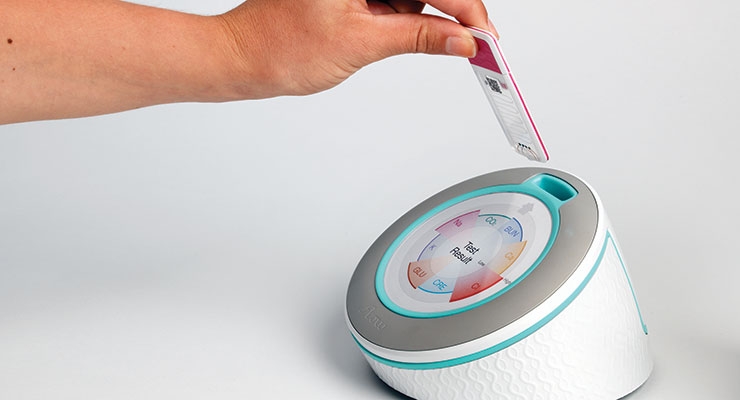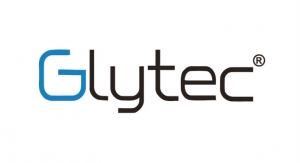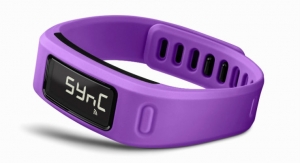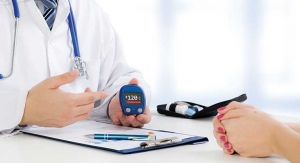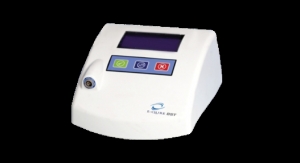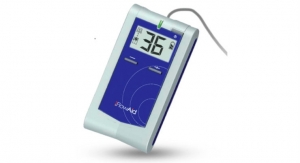Michael Barbella, Managing Editor06.06.17
Imagine for a moment, redesigning the toilet.
The very thought is intimidating; it’s a task best left to intellects, engineers, and industrial designers—i.e., people like Sam Sheard, Pierre Papet, and Victor Johansson.
Nearly four years ago, the Central St. Martin’s College (London) graduates gained notoriety for their futuristic-looking overhaul of the common commode, capturing top honors in a competition sponsored by United-Kingdom-based plumbing giant Dyno. The trio integrated various influences in their creation, mixing Eastern approaches to bathroom habits with Western tradition and cutting-edge technology to devise the “wellbeing toilet.”
Featuring an ergonomically friendly shape, the prototype toilet encourages users to squat rather than sit. A slight forward-angled seat juts from the pedestal, inducing bathroom-goers to sit cross-legged with their feet on the edge of the porcelain throne as they heed nature’s call. Essentially a hybrid between the chair-like structure of modern commodes and the angled position of squat toilets, the invention is designed to help people adopt new lavatory habits by conforming to a different (albeit healthier) sitting position.
“There’s a school of thought that [says] if you sit in a certain position, the comfort factor of doing your daily can actually help healthwise as well, in terms of hemorrhoids and in terms of colon cancer,” reported fashion designer and Red or Dead label co-founder Wayne Hemingway, one of several Dyno competition judges. “If we can contribute towards that in one small way, then this has been a significant project.”
The project’s significance, however, is far greater than organizers realize. Perhaps more important than advocating better potty positions is the prototype toilet’s ability to analyze urine and other waste matter to check for diseases such as diabetes and test for nutritional deficiencies as well as pregnancy.
“It’s what you’d get if you go to the doctor and they check for diabetes, kidney disease, or phosphates in the urine,” Sheard noted. “The industry connected with pregnancy tests has huge costs both financially and environmentally—with resources, manufacturing, plastic packaging, and distribution—and if you can encompass that within a toilet, you can have an impact. The reason we went down the well-being route is we think it’s socially relevant at the moment. People are interested in health, so we thought that would be our primary focus.”
Quite an insightful decision on the collegians’ part: Consumer obsession with health management and overall wellness is spawning an astounding bull market in home healthcare, with the domestic medical equipment segment projected to grow 7.8 percent annually to reach $48.47 billion by 2022, according to Meticulous Market Research Pvt. Ltd. data. Fostering that growth is the planet’s aging population as well as an increasing number of elderly people willing and physically able to remain in their own homes. Also contributing to the burgeoning market is the increase in insured Americans, improved receptivity to home healthcare among doctors and health insurers, technological advancements such as wearable devices and mobile health (mHealth) applications, and government initiatives to promote at-home diagnostics.
Developed nations like Japan and the United States have aggressively championed home healthcare initiatives in an effort to control skyrocketing medical costs, while the idea is slowly gaining popularity in developing countries like India, where patient and price-centric markets are the norm.
At-home testing is amassing acceptance among healthcare practitioners as well due to reduced turnaround times, overall product manageability, improved diagnostic accuracy, and minimal laboratory (patient) visits.
“The at-home testing market is an interesting space for patients, healthcare professionals, and device developers alike, as at-home tests fit neatly into both the early and late stages of the care pathway. The fitness/wellness devices can be used to provide feedback on activities [that] may prevent or delay the onset of chronic illness,” said Carmelo Volpe, head of clinical diagnostics for Cambridge Consultants, a product design and development firm with laboratories in Cambridge, United Kingdom, and Boston, Mass. “The market for at-home tests has grown and diversified over the last few years. With the worldwide increase in chronic conditions combined with the rationalization of healthcare services, the need for patients to become actively involved in managing their own health has never been greater. Indeed, this need will only increase as life expectancy continues to improve across the world. As a result, there has been an increase in the range of monitoring and testing devices aimed both at the health-conscious consumer (typically fitness and wellness devices) as well as the patient (more traditional medical devices).”
Indeed, the market is awash in home-based diagnostics as pharmacies, supermarkets, retail stores, device manufacturers, and laboratory companies alike capitalize on a societal penchant for better self-management of health conditions. PTS Diagnostics, for instance, targets 98 percent of U.S. adults with high HDL (good) cholesterol through its CardioChek lipid analyzer portfolio.
Programmable in nine languages, the products provide cholesterol screening results (including total, HDL, tri-glycerides, and glucose levels) in as little as 90 seconds, and its PTS Panels lipid panel test strips boast a measurement range of 20 to 120 mg/dL (0.52 to 3.1 mmol/L) for HDL. The test strips measure total cholesterol (TC), HDL, and triglycerides, and also calculate LDL cholesterol as well as TC/HDL ratio.
LabCorp’s Lab-in-an-Envelope service screens for cholesterol biomarkers too, but expands the universe of detectable disease harbingers to include analyses for prostate-specific antigen (PSA), thyroid-stimulating hormone (TSH), C-reactive protein (indicative of inflammation), cotinine, creatinine, blood urea nitrogen, AST/ALT (liver damage/injury), testosterone, and vitamin D.
23andMe turned that cosmic expansion up a notch in April by securing the first direct-to-consumer genetic test approval from the U.S. Food and Drug Administration (FDA). The decision allows the firm to market tests that can determine a genetic predisposition to 10 diseases: Parkinson’s, late-onset Alzheimer’s, celiac disease, early-onset primary dystonia (a movement disorder), Alpha-1 antitrypsin deficiency (elevated risk of lung and liver disease), Factor XI deficiency (blood clotting disorder), Gaucher disease type 1 (organ and tissue disorder), and G6PD (red blood cell condition), among others.
The assays isolate DNA from a saliva sample and analyze it for more than 500,000 genetic variants possibly related to the approved diseases. 23andMe executives claim the company has worked tirelessly to show the FDA its reports are easy for customers to understand and meet the agency’s requirements for accuracy.
Nevertheless, the FDA cautioned consumers against misinterpreting 23andMe test results, noting that genetic risk is just one of many factors that can contribute to the development of certain health conditions or diseases.
Ironically, those same concerns surfaced more than three years ago when the FDA banned 23andMe from selling its DNA test kits. At the time, the agency said it feared the genetic data would encourage patients to either seek procedures they didn’t need or stop taking certain medications. The FDA also barred the company from offering health reports because it failed to adequately prove the accuracy of the risk analysis associated with its genetic tests.
Since then, 23andMe has worked with the FDA to gain product approval. To ultimately win over regulators, the company conducted “user comprehension testing” to prove its customers fully comprehend the meaning of the genetic health risks linked with its kits, a 23andMe spokesperson told The Verge. The Silicon Valley company also submitted studies proving its DNA tests “correctly and consistently” identified variants connected to the 10 diseases and conditions.
23andMe’s regulatory struggles exemplify one of the more stubborn challenges bedeviling the at-home testing market. Although research indicates that people understand the implications of do-it-yourself diagnostics, there are still lingering concerns over the authenticity of results.
Even when accurate, however, at-home health tests may not be a reliable indicator of disease, skeptics claim. Direct-to-consumer (DTC) genetic assays are particularly untrustworthy, as these tests rarely include the comprehensive analysis of disease-related genes that professional clinics provide and they rarely account for patients’ family histories. In addition, some genetic testing firms provide results based on single nucleotide polymorphisms (SNPs)—common genetic variations that can act as biological markers for disease.
But results based on an analysis of multiple SNPs is inferior to full gene sequencing, which most DTC firms do not offer, industry sources note.
“At-home testing devices need to meet the same clinical standards as professional use diagnostic devices, but they need also to demonstrate that they are safe and effective in the hands of untrained users,” said John Kelly, founder and CEO of Atomo Diagnostics, an Australian designer and manufacturer of rapid diagnostic tests. “This is easier said than done. Regulators quite rightly set a high bar for self-test products. It is imperative not only that the lay user can perform the diagnostic test correctly and thereby get an accurate result, but also that they can then interpret that result and make the appropriate link to care.”
“For many conditions, the concept of at-home testing is new,” he continued. “Existing multi-component test kits, as used by professionals, are just too complex for use by lay self-testers and can produce high error rates due to poor usability. Atomo has sought to overcome such challenges by integrating the components of a rapid diagnostic test into a single, easy-to-use device. We put the needs of the end user at the forefront of the design process.”
Indeed, simplicity is paramount in designing home diagnostic devices due to the diversity of end users. Wide variations in age, economic background, and education levels necessitate the development of products that are easy to operate, fail safely, and are relatively inexpensive.
Products like the Trak Male Fertility System, a hockey puck-shaped sperm count measurement tool that syncs with a smartphone and provides FDA-approved results in just 45 minutes. Users need only provide a semen sample for this test; the device has the more difficult job of tallying sperm.
The Trak uses centrifugal force to isolate and quantify sperm cells through specially designed (and disposable) single-use cartridges. The system, developed by Livermore, Calif.-based Sandstone Diagnostics Inc., pairs with a mobile app (available free on Google Play, the Apple App Store, and Amazon), to allow men to enter, track, and compare their results to population statistics through the cloud, and receive personalized feedback on ways to boost their sperm count.
Operational simplicity, for the most part, has long been a design staple of home diagnostic products, having been incorporated into pregnancy tests (urine specimens), blood glucose monitoring (finger pricks), and cholesterol screening (blood samples). But technological advancements and the advent of mHealth are enabling consumers to test for more complex or life-threatening conditions in private.
Bethlehem, Pa.-based OraSure Technologies Inc., for example, offers an easy gum-swab test for HIV that provides results in 20-40 minutes. The assay (Oraquick) can detect both HIV-1, the most common form of the virus, and HIV-2, a strain rare to the United States, with an FDA-confirmed 92 percent accuracy rate for positive tests and a 99 percent accuracy rate for negative tests.
Similarly, ThyroChek’s 10-minute TSH assay gives consumers the power to detect hypothyroidism, an often undiagnosed condition that affects nearly 10 percent of U.S. adults and can lead to various health issues including obesity and heart disease. The assay is touted as the only FDA-approved rapid test for elevated thyroid-stimulating hormone (TSH), the first clinical indicator of hypothyroidism.
Genespots Healthcare Inc., meanwhile, is aiming to revolutionize cancer detection with its at-home diagnostic test currently under development. The company’s Cancer HEALTHLOGGER device assimilates a microfluidic analysis system and a special algorithm-driven data chip that evaluates hybridization DNA spots to identify lung, breast, or prostate cancer cells. All that’s needed is a drop of blood.
“The performance levels of rapid tests are now approaching those of laboratory-based tests,” Atomo’s Kelly declared. “At-home diagnostic testing and health monitoring are areas that are now growing rapidly. Blood glucose testing is well-established, and has served to demonstrate the acceptability of self testing. Other sectors showing promise include infectious disease testing, particularly sexual health, and a number of wellness conditions such as vitamin D, allergy, and screening for celiac disease.”
As the list of home testing options grows, so too is the market appetite for multipurpose products. Some companies in the space are beginning to abandon the traditional one-test-per-device concept in favor of versatility, designing gadgets that can screen for more than one condition or disease.
Atomo is one such company on the forefront of multi-functional diagnostics. Through a series of grants—including a $3.6 million endowment from the Bill and Melinda Gates Foundation—the firm has developed a next-generation HIV self-test for inhabitants of developing and resource-poor countries. Executives describe the AtomoRapid HIV as an “all in one Bluetooth-enabled device, as well as a malaria testing kit.”
Two diseases, one device.
Cambridge Consultants is also upending the single-test design approach with its Flow Health Hub, a proof-of-concept invention that would allow consumers to take better charge of their health—either through personal fitness tracking or pre-existing conditions monitoring.
The Flow Health Hub concept consists of a reader and a set of color-coded consumable cartridges for collecting body fluid samples such as blood, urine, and saliva. Users would select the appropriate cartridge—e.g., the one for blood features an integrated lancet for finger stick testing—then take a sample, and simply insert the cartridge into the reader.
The device would use established microfluidic technology to perform various standard tests such as lipid, metabolic, renal, and electrolyte panels. Results are provided in minutes, with algorithms analyzing the data and alerting the patient’s doctor if necessary, according to the company.
The product could provide an early warning system for problems such as high cholesterol levels or changes in renal function—and make recommendations for corrective action. It also could link results to apps to track an individual’s fitness levels and help maximize the training regime, diet, and performance.
With its multi-functional testing abilities, the Flow Health Hub would be ideal for home health enthusiasts: Diabetics, for example, or patients at risk of heart disease due to high cholesterol levels could build a trend history of blood glucose and/or cholesterol levels, and ensure their doctor is alerted only for signs of trouble. Fitness buffs, on the other hand, could use the device to check hydration levels and determine when to drink more fluids or to rest.
“More recently, we’re seeing two trends in devices designed for use at home: multiple tests per device and consumerization of medical devices,” Volpe said. “Companies such as Scanadu and Cor are developing devices that are able to measure, either via sensors on the skin or from small drops of blood, a number of general physiological parameters and provide the readout through a wireless link to a smartphone or tablet. The emergence of apps [that] combine multiple data sources with intuitive interfaces has created an opportunity for product developers to simplify devices through the use of human factors, user interface expertise, and good industrial design. This new style of ‘consumerized’ diagnostics still needs to meet the clinical needs of healthcare professionals but these consumerized medical devices are showing what can be done.”
And the possibilities are truly remarkable. Consider, for instance, the promise rendered by Cue Inc.’s tabletop analyzer, which uses a swab of saliva, nasal fluid, or blood to analyze the body’s biological conduct. The firm claims its diagnostic kit not only can detect illness, it also can check vitamin or testosterone levels, or help women determine the best times to conceive—tests usually consigned to the lab or doctor’s office.
Cue’s lineup of assays are similar in performance to their lab counterparts, and in some cases, deliver results quicker than clinics, company executives contend. Case in point: The flu test is three times faster than its conventional counterparts, and the vitamin D assay takes only 10 minutes to produce results.
Last year, Cue began working with Janssen Pharmaceuticals Inc., one of the Janssen Pharmaceutical Companies of Johnson & Johnson, to develop an HIV viral load test using its proprietary diagnostic platform. The deal was facilitated by Johnson & Johnson Innovation.
Augmenting Cue’s five-test platform of vitamin D, inflammation, influenza, testosterone, and fertility assays is a mobile app that offers a “new way” of interacting with personal health. The FluMap app, for example, visualizes the presence of the flu in any given community, while the Life Feed app reveals the interplay of activity, food, and sleep on daily life; it blends activity and sleep data derived from a smartphone or wearable device with lifestyle indicators to recommend foods and activities proven to support health.
Mobile apps were a key component of Scanadu’s much-hyped Scout, a home diagnostic tool designed to measure body temperature, blood pressure, heart rate, and various other biological functions. A concept spawned from the XPRIZE Foundation’s Qualcomm Tricorder competition, the device was designed to transmit data to a smartphone app as well as to physicians if so desired.
Last month, however, Scanadu shut down support for the Scout device under FDA orders. The agency did not provide a reason for its decision (announced in late 2016), but a Scanadu spokeswoman told trade media the tricorder product was simply part of a study that had concluded. “From the beginning of the campaign, this was an investigational device that was part of a study which has now reached its endpoint...” the spokeswoman said.
Regardless of its true cause of death, the Scout’s fate is indicative of the challenge awaiting firms that rely too heavily on “consumerized diagnostics.”
“A significant challenge relates to the number of new entrants to the remote patient monitoring industry that are ill-prepared to effectively support patients and physicians across the spectrum of challenges/issues that relate to operating in this space, leading to skeptical offerings, suboptimal outcomes, and potentially frustrated customers,” mused David Tom, general manager and vice president of Alere Home Monitoring. “While technology is readily available to enable these models, it takes more than technology to operate effectively in this space. Many remote monitoring providers are generating solutions through trial and error. Some providers tout technologies that aren’t necessarily ready for primetime but create buzz. Some providers have customer-facing technology but are ill prepared to scale their service and support models or the data management infrastructure to meet the needs of this rapidly expanding market.”
“For example, Alere Home Monitoring provides not only remote patient monitoring services, but in some instances, provides testing equipment, test supplies, wound care supplies, patient outreach, clinic support, and a range of essential customer support services formulated over time, through our experience working with numerous clinics while operating in this highly regulated environment,” Tom continued. “It’s only through the scalable convergence of effective technology, optimized healthcare data management, and experienced patient service/support that the patient, the physician, and the reimbursement entities are served harmoniously.”
The very thought is intimidating; it’s a task best left to intellects, engineers, and industrial designers—i.e., people like Sam Sheard, Pierre Papet, and Victor Johansson.
Nearly four years ago, the Central St. Martin’s College (London) graduates gained notoriety for their futuristic-looking overhaul of the common commode, capturing top honors in a competition sponsored by United-Kingdom-based plumbing giant Dyno. The trio integrated various influences in their creation, mixing Eastern approaches to bathroom habits with Western tradition and cutting-edge technology to devise the “wellbeing toilet.”
Featuring an ergonomically friendly shape, the prototype toilet encourages users to squat rather than sit. A slight forward-angled seat juts from the pedestal, inducing bathroom-goers to sit cross-legged with their feet on the edge of the porcelain throne as they heed nature’s call. Essentially a hybrid between the chair-like structure of modern commodes and the angled position of squat toilets, the invention is designed to help people adopt new lavatory habits by conforming to a different (albeit healthier) sitting position.
“There’s a school of thought that [says] if you sit in a certain position, the comfort factor of doing your daily can actually help healthwise as well, in terms of hemorrhoids and in terms of colon cancer,” reported fashion designer and Red or Dead label co-founder Wayne Hemingway, one of several Dyno competition judges. “If we can contribute towards that in one small way, then this has been a significant project.”
The project’s significance, however, is far greater than organizers realize. Perhaps more important than advocating better potty positions is the prototype toilet’s ability to analyze urine and other waste matter to check for diseases such as diabetes and test for nutritional deficiencies as well as pregnancy.
“It’s what you’d get if you go to the doctor and they check for diabetes, kidney disease, or phosphates in the urine,” Sheard noted. “The industry connected with pregnancy tests has huge costs both financially and environmentally—with resources, manufacturing, plastic packaging, and distribution—and if you can encompass that within a toilet, you can have an impact. The reason we went down the well-being route is we think it’s socially relevant at the moment. People are interested in health, so we thought that would be our primary focus.”
Quite an insightful decision on the collegians’ part: Consumer obsession with health management and overall wellness is spawning an astounding bull market in home healthcare, with the domestic medical equipment segment projected to grow 7.8 percent annually to reach $48.47 billion by 2022, according to Meticulous Market Research Pvt. Ltd. data. Fostering that growth is the planet’s aging population as well as an increasing number of elderly people willing and physically able to remain in their own homes. Also contributing to the burgeoning market is the increase in insured Americans, improved receptivity to home healthcare among doctors and health insurers, technological advancements such as wearable devices and mobile health (mHealth) applications, and government initiatives to promote at-home diagnostics.
Developed nations like Japan and the United States have aggressively championed home healthcare initiatives in an effort to control skyrocketing medical costs, while the idea is slowly gaining popularity in developing countries like India, where patient and price-centric markets are the norm.
At-home testing is amassing acceptance among healthcare practitioners as well due to reduced turnaround times, overall product manageability, improved diagnostic accuracy, and minimal laboratory (patient) visits.
“The at-home testing market is an interesting space for patients, healthcare professionals, and device developers alike, as at-home tests fit neatly into both the early and late stages of the care pathway. The fitness/wellness devices can be used to provide feedback on activities [that] may prevent or delay the onset of chronic illness,” said Carmelo Volpe, head of clinical diagnostics for Cambridge Consultants, a product design and development firm with laboratories in Cambridge, United Kingdom, and Boston, Mass. “The market for at-home tests has grown and diversified over the last few years. With the worldwide increase in chronic conditions combined with the rationalization of healthcare services, the need for patients to become actively involved in managing their own health has never been greater. Indeed, this need will only increase as life expectancy continues to improve across the world. As a result, there has been an increase in the range of monitoring and testing devices aimed both at the health-conscious consumer (typically fitness and wellness devices) as well as the patient (more traditional medical devices).”
Indeed, the market is awash in home-based diagnostics as pharmacies, supermarkets, retail stores, device manufacturers, and laboratory companies alike capitalize on a societal penchant for better self-management of health conditions. PTS Diagnostics, for instance, targets 98 percent of U.S. adults with high HDL (good) cholesterol through its CardioChek lipid analyzer portfolio.
Programmable in nine languages, the products provide cholesterol screening results (including total, HDL, tri-glycerides, and glucose levels) in as little as 90 seconds, and its PTS Panels lipid panel test strips boast a measurement range of 20 to 120 mg/dL (0.52 to 3.1 mmol/L) for HDL. The test strips measure total cholesterol (TC), HDL, and triglycerides, and also calculate LDL cholesterol as well as TC/HDL ratio.
LabCorp’s Lab-in-an-Envelope service screens for cholesterol biomarkers too, but expands the universe of detectable disease harbingers to include analyses for prostate-specific antigen (PSA), thyroid-stimulating hormone (TSH), C-reactive protein (indicative of inflammation), cotinine, creatinine, blood urea nitrogen, AST/ALT (liver damage/injury), testosterone, and vitamin D.
23andMe turned that cosmic expansion up a notch in April by securing the first direct-to-consumer genetic test approval from the U.S. Food and Drug Administration (FDA). The decision allows the firm to market tests that can determine a genetic predisposition to 10 diseases: Parkinson’s, late-onset Alzheimer’s, celiac disease, early-onset primary dystonia (a movement disorder), Alpha-1 antitrypsin deficiency (elevated risk of lung and liver disease), Factor XI deficiency (blood clotting disorder), Gaucher disease type 1 (organ and tissue disorder), and G6PD (red blood cell condition), among others.
The assays isolate DNA from a saliva sample and analyze it for more than 500,000 genetic variants possibly related to the approved diseases. 23andMe executives claim the company has worked tirelessly to show the FDA its reports are easy for customers to understand and meet the agency’s requirements for accuracy.
Nevertheless, the FDA cautioned consumers against misinterpreting 23andMe test results, noting that genetic risk is just one of many factors that can contribute to the development of certain health conditions or diseases.
Ironically, those same concerns surfaced more than three years ago when the FDA banned 23andMe from selling its DNA test kits. At the time, the agency said it feared the genetic data would encourage patients to either seek procedures they didn’t need or stop taking certain medications. The FDA also barred the company from offering health reports because it failed to adequately prove the accuracy of the risk analysis associated with its genetic tests.
Since then, 23andMe has worked with the FDA to gain product approval. To ultimately win over regulators, the company conducted “user comprehension testing” to prove its customers fully comprehend the meaning of the genetic health risks linked with its kits, a 23andMe spokesperson told The Verge. The Silicon Valley company also submitted studies proving its DNA tests “correctly and consistently” identified variants connected to the 10 diseases and conditions.
23andMe’s regulatory struggles exemplify one of the more stubborn challenges bedeviling the at-home testing market. Although research indicates that people understand the implications of do-it-yourself diagnostics, there are still lingering concerns over the authenticity of results.
Even when accurate, however, at-home health tests may not be a reliable indicator of disease, skeptics claim. Direct-to-consumer (DTC) genetic assays are particularly untrustworthy, as these tests rarely include the comprehensive analysis of disease-related genes that professional clinics provide and they rarely account for patients’ family histories. In addition, some genetic testing firms provide results based on single nucleotide polymorphisms (SNPs)—common genetic variations that can act as biological markers for disease.
But results based on an analysis of multiple SNPs is inferior to full gene sequencing, which most DTC firms do not offer, industry sources note.
“At-home testing devices need to meet the same clinical standards as professional use diagnostic devices, but they need also to demonstrate that they are safe and effective in the hands of untrained users,” said John Kelly, founder and CEO of Atomo Diagnostics, an Australian designer and manufacturer of rapid diagnostic tests. “This is easier said than done. Regulators quite rightly set a high bar for self-test products. It is imperative not only that the lay user can perform the diagnostic test correctly and thereby get an accurate result, but also that they can then interpret that result and make the appropriate link to care.”
“For many conditions, the concept of at-home testing is new,” he continued. “Existing multi-component test kits, as used by professionals, are just too complex for use by lay self-testers and can produce high error rates due to poor usability. Atomo has sought to overcome such challenges by integrating the components of a rapid diagnostic test into a single, easy-to-use device. We put the needs of the end user at the forefront of the design process.”
Indeed, simplicity is paramount in designing home diagnostic devices due to the diversity of end users. Wide variations in age, economic background, and education levels necessitate the development of products that are easy to operate, fail safely, and are relatively inexpensive.
Products like the Trak Male Fertility System, a hockey puck-shaped sperm count measurement tool that syncs with a smartphone and provides FDA-approved results in just 45 minutes. Users need only provide a semen sample for this test; the device has the more difficult job of tallying sperm.
The Trak uses centrifugal force to isolate and quantify sperm cells through specially designed (and disposable) single-use cartridges. The system, developed by Livermore, Calif.-based Sandstone Diagnostics Inc., pairs with a mobile app (available free on Google Play, the Apple App Store, and Amazon), to allow men to enter, track, and compare their results to population statistics through the cloud, and receive personalized feedback on ways to boost their sperm count.
Operational simplicity, for the most part, has long been a design staple of home diagnostic products, having been incorporated into pregnancy tests (urine specimens), blood glucose monitoring (finger pricks), and cholesterol screening (blood samples). But technological advancements and the advent of mHealth are enabling consumers to test for more complex or life-threatening conditions in private.
Bethlehem, Pa.-based OraSure Technologies Inc., for example, offers an easy gum-swab test for HIV that provides results in 20-40 minutes. The assay (Oraquick) can detect both HIV-1, the most common form of the virus, and HIV-2, a strain rare to the United States, with an FDA-confirmed 92 percent accuracy rate for positive tests and a 99 percent accuracy rate for negative tests.
Similarly, ThyroChek’s 10-minute TSH assay gives consumers the power to detect hypothyroidism, an often undiagnosed condition that affects nearly 10 percent of U.S. adults and can lead to various health issues including obesity and heart disease. The assay is touted as the only FDA-approved rapid test for elevated thyroid-stimulating hormone (TSH), the first clinical indicator of hypothyroidism.
Genespots Healthcare Inc., meanwhile, is aiming to revolutionize cancer detection with its at-home diagnostic test currently under development. The company’s Cancer HEALTHLOGGER device assimilates a microfluidic analysis system and a special algorithm-driven data chip that evaluates hybridization DNA spots to identify lung, breast, or prostate cancer cells. All that’s needed is a drop of blood.
“The performance levels of rapid tests are now approaching those of laboratory-based tests,” Atomo’s Kelly declared. “At-home diagnostic testing and health monitoring are areas that are now growing rapidly. Blood glucose testing is well-established, and has served to demonstrate the acceptability of self testing. Other sectors showing promise include infectious disease testing, particularly sexual health, and a number of wellness conditions such as vitamin D, allergy, and screening for celiac disease.”
As the list of home testing options grows, so too is the market appetite for multipurpose products. Some companies in the space are beginning to abandon the traditional one-test-per-device concept in favor of versatility, designing gadgets that can screen for more than one condition or disease.
Atomo is one such company on the forefront of multi-functional diagnostics. Through a series of grants—including a $3.6 million endowment from the Bill and Melinda Gates Foundation—the firm has developed a next-generation HIV self-test for inhabitants of developing and resource-poor countries. Executives describe the AtomoRapid HIV as an “all in one Bluetooth-enabled device, as well as a malaria testing kit.”
Two diseases, one device.
Cambridge Consultants is also upending the single-test design approach with its Flow Health Hub, a proof-of-concept invention that would allow consumers to take better charge of their health—either through personal fitness tracking or pre-existing conditions monitoring.
The Flow Health Hub concept consists of a reader and a set of color-coded consumable cartridges for collecting body fluid samples such as blood, urine, and saliva. Users would select the appropriate cartridge—e.g., the one for blood features an integrated lancet for finger stick testing—then take a sample, and simply insert the cartridge into the reader.
The device would use established microfluidic technology to perform various standard tests such as lipid, metabolic, renal, and electrolyte panels. Results are provided in minutes, with algorithms analyzing the data and alerting the patient’s doctor if necessary, according to the company.
The product could provide an early warning system for problems such as high cholesterol levels or changes in renal function—and make recommendations for corrective action. It also could link results to apps to track an individual’s fitness levels and help maximize the training regime, diet, and performance.
With its multi-functional testing abilities, the Flow Health Hub would be ideal for home health enthusiasts: Diabetics, for example, or patients at risk of heart disease due to high cholesterol levels could build a trend history of blood glucose and/or cholesterol levels, and ensure their doctor is alerted only for signs of trouble. Fitness buffs, on the other hand, could use the device to check hydration levels and determine when to drink more fluids or to rest.
“More recently, we’re seeing two trends in devices designed for use at home: multiple tests per device and consumerization of medical devices,” Volpe said. “Companies such as Scanadu and Cor are developing devices that are able to measure, either via sensors on the skin or from small drops of blood, a number of general physiological parameters and provide the readout through a wireless link to a smartphone or tablet. The emergence of apps [that] combine multiple data sources with intuitive interfaces has created an opportunity for product developers to simplify devices through the use of human factors, user interface expertise, and good industrial design. This new style of ‘consumerized’ diagnostics still needs to meet the clinical needs of healthcare professionals but these consumerized medical devices are showing what can be done.”
And the possibilities are truly remarkable. Consider, for instance, the promise rendered by Cue Inc.’s tabletop analyzer, which uses a swab of saliva, nasal fluid, or blood to analyze the body’s biological conduct. The firm claims its diagnostic kit not only can detect illness, it also can check vitamin or testosterone levels, or help women determine the best times to conceive—tests usually consigned to the lab or doctor’s office.
Cue’s lineup of assays are similar in performance to their lab counterparts, and in some cases, deliver results quicker than clinics, company executives contend. Case in point: The flu test is three times faster than its conventional counterparts, and the vitamin D assay takes only 10 minutes to produce results.
Last year, Cue began working with Janssen Pharmaceuticals Inc., one of the Janssen Pharmaceutical Companies of Johnson & Johnson, to develop an HIV viral load test using its proprietary diagnostic platform. The deal was facilitated by Johnson & Johnson Innovation.
Augmenting Cue’s five-test platform of vitamin D, inflammation, influenza, testosterone, and fertility assays is a mobile app that offers a “new way” of interacting with personal health. The FluMap app, for example, visualizes the presence of the flu in any given community, while the Life Feed app reveals the interplay of activity, food, and sleep on daily life; it blends activity and sleep data derived from a smartphone or wearable device with lifestyle indicators to recommend foods and activities proven to support health.
Mobile apps were a key component of Scanadu’s much-hyped Scout, a home diagnostic tool designed to measure body temperature, blood pressure, heart rate, and various other biological functions. A concept spawned from the XPRIZE Foundation’s Qualcomm Tricorder competition, the device was designed to transmit data to a smartphone app as well as to physicians if so desired.
Last month, however, Scanadu shut down support for the Scout device under FDA orders. The agency did not provide a reason for its decision (announced in late 2016), but a Scanadu spokeswoman told trade media the tricorder product was simply part of a study that had concluded. “From the beginning of the campaign, this was an investigational device that was part of a study which has now reached its endpoint...” the spokeswoman said.
Regardless of its true cause of death, the Scout’s fate is indicative of the challenge awaiting firms that rely too heavily on “consumerized diagnostics.”
“A significant challenge relates to the number of new entrants to the remote patient monitoring industry that are ill-prepared to effectively support patients and physicians across the spectrum of challenges/issues that relate to operating in this space, leading to skeptical offerings, suboptimal outcomes, and potentially frustrated customers,” mused David Tom, general manager and vice president of Alere Home Monitoring. “While technology is readily available to enable these models, it takes more than technology to operate effectively in this space. Many remote monitoring providers are generating solutions through trial and error. Some providers tout technologies that aren’t necessarily ready for primetime but create buzz. Some providers have customer-facing technology but are ill prepared to scale their service and support models or the data management infrastructure to meet the needs of this rapidly expanding market.”
“For example, Alere Home Monitoring provides not only remote patient monitoring services, but in some instances, provides testing equipment, test supplies, wound care supplies, patient outreach, clinic support, and a range of essential customer support services formulated over time, through our experience working with numerous clinics while operating in this highly regulated environment,” Tom continued. “It’s only through the scalable convergence of effective technology, optimized healthcare data management, and experienced patient service/support that the patient, the physician, and the reimbursement entities are served harmoniously.”

